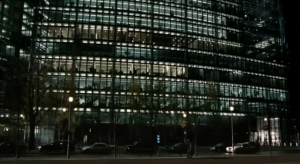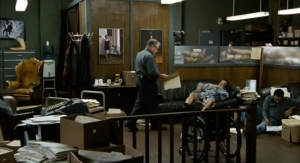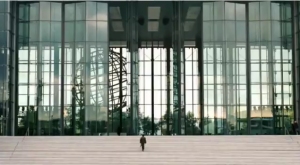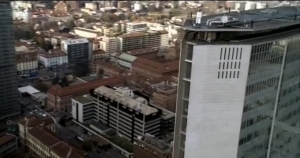The Architecture of The International
In reviewing The International with my cohort Alesha, we were impressed with the way in which architecture helped tell the story and reinforce the characters throughout the film. By surrounding the plot with specific architecture, the architecture can “become a character in the film,” according to director Tom Tykwer. In a way, the film acts as a ‘grand tour’ of European and American architecture in general, although not as the way in which we might understand each city if we visited them personally. In fact, the filmmakers chose to represent each city in a ‘themed’ manner; Berlin in a sleek, modern and transparent way, New York City in a thick, cluttered manner, and Milan as a combination of the two.
Berlin

NYC

Milan
We find that these moves across architectural themes concur with the characters in the film. The antagonists in the film are the members of of the IBBC, who are involved in funding international conflicts and weapons deals in order to secure a hold in the resulting debt. Each time we see these characters in their home element, they are surrounded by sleek, contemporary architecture, typically accompanied with a lot of glass and modern furniture from architects such as Mies and Corbusier. The architecture serves to reinforce the IBBC’s power and influence in the world: each time we see the antagonists in power, they are surrounded by ‘their’ architecture. There is a scene in which the main protagonist, Louis Salinger, enters the IBBC headquarters in his hunt for evidence to bring the mega-corporation down, and as if to establish just how little power he has over the situation, he is shown as a small lone figure walking up the steps into the enormous headquarters building. It comes as little surprise that his efforts there are soon thwarted by the company. Here the filmmakers also mention an ‘irony of transparency,’ in which the IBBC is shown behind transparent glass, yet their inner workings are done in complete secrecy.
 As the plot begins to shift, we enter Milan, where the characters in the film stand on more equal ground, the architecture there reflect that. Most of the action takes place in a square surrounded on one side by the headquarters of the Calvini corporation (one of the major players in the IBBC weapons deal), and on the other by a 70’s-era coffee shop and the Centrale station built during Mussolini’s regime (representing the older, heavy and ‘having character’ themes of the protagonists). As the plot begins to shift away from the power of the IBBC (it is here that the company makes one of its major mistakes), the modern architecture begins to slip away.
As the plot begins to shift, we enter Milan, where the characters in the film stand on more equal ground, the architecture there reflect that. Most of the action takes place in a square surrounded on one side by the headquarters of the Calvini corporation (one of the major players in the IBBC weapons deal), and on the other by a 70’s-era coffee shop and the Centrale station built during Mussolini’s regime (representing the older, heavy and ‘having character’ themes of the protagonists). As the plot begins to shift away from the power of the IBBC (it is here that the company makes one of its major mistakes), the modern architecture begins to slip away.
As we finally move into the world of Salinger and his partner Elenore Whitman in NYC, the IBBC finally begins to lose control. In fact, the scene in which we see the assassin for the IBBC is in the Guggenheim museum by Frank Lloyd Wright (a clean, modern ‘island’ in the sea of NYC, and a fitting place for the IBBC), yet by the end of the scene the interior of the building has been reduced to shambles. One interesting note is that the filmmakers chose to rebuild the interior of the museum on a set in Berlin, rather than deal with the destruction on the real location.
The last scenes of the movie take place in Istanbul, and finally the place in which the IBBC and its president, Jonas Skaarson are brought to their knees. As we witness the scenes leading up to the death of Skaarson, long-gone are the sleek, contemporary buildings so synonymous with the company, which have been replaced by the chaos and confusion of the Grand Bazaar. Skaarson’s face reflects his the loss of control that he and his company are experiencing.
Overall, I enjoyed the way in which architecture can help reinforce the plot of a film, without outright saying so (doom and gloom = evil, bright and glorious = good, for example). The effect can be subtle if you’re not looking for it, but it opens up whole new ways of looking at film if you give it a chance.


Leave a comment